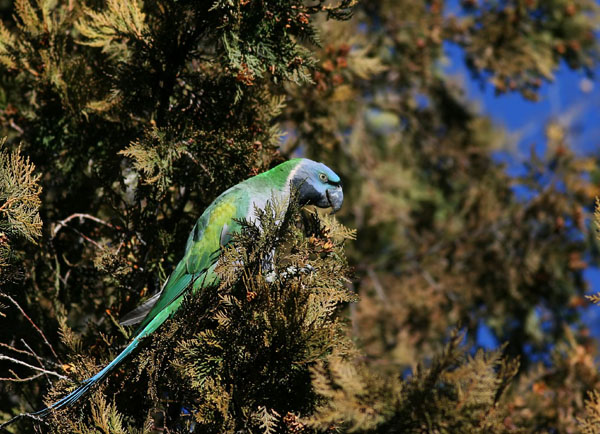Derby's Parakeet
IUCN
LCBasic Information
Scientific classification
- name:Derby's Parakeet
- Scientific Name:Derby's Parakeet,Parrot, Oriole
- Outline:Climbing birds
- Family:Psittaciformes
Vital signs
- length:22-36cm
- Weight:85-168g
- lifetime:About 50 years
Feature
The tongue is very developed and can imitate human "speech"
Distribution and Habitat
It is commonly found in southeastern Tibet, southwestern Sichuan, western and northwestern Yunnan in China. It is distributed in northeastern India abroad.
It feeds mostly in coniferous forests, up to 4,000 meters above sea level. It occasionally visits farmland and orchards. It flies quickly in groups, forages for food, and reproduces. Because young birds are often captured and sold, it is endangered in some areas.
Appearance
The body is large, the head appears round and large, and the chest is purple. The male bird has light green around the eyes and forehead, and the front crown is dyed blue. The front crown of the female bird is darker than that of the male bird. The head and chest are purple-blue gray, with wide black mustaches, a narrow black forehead band extending into the eye line, a long tail, and the central tail feathers gradually turn blue. The difference from other parrots with gray heads is that the upper part of the neck and chest to the upper abdomen is grape purple, and there is no chestnut spot on the shoulder. The iris is yellow, the beak of the male bird is red on the upper beak and black on the lower beak, and the female bird's beak is completely black, and the feet are gray.
Details
The Great Purple-breasted Parrot is a medium-sized bird. In the wild, it usually moves in groups of dozens. In the breeding season, it will form a group of up to 50. When it gathers, it is very noisy and rarely moves in pairs or alone. It mostly feeds in coniferous forests and can reach an altitude of 4,000 meters. It occasionally visits farmland and orchards. It flies quickly in groups, forages, and reproduces. Because young birds are often captured and sold, they are endangered in some areas.
They are very beautiful in appearance. Most of their feathers are green, their heads are light blue-purple, and their chests, abdomens and thighs are light purple, which is also the origin of their name. There is a black band connecting the two eyes, and there is a large black spot on both sides of the lower beak that runs from the lower cheek to the side of the neck. The female bird looks similar to the male bird. The most obvious difference is that the male bird has a red beak, while the female bird is black, and the young bird is red with yellow. Therefore, just looking at the beak, you can basically tell the gender and the young.

From February to April every year, the great purple-breasted parrot enters the mating and breeding season. During this period, the great purple-breasted parrot will choose a large tree with a tree hole as a nesting tree. After mating, the female bird will nest and lay eggs in the tree hole of the large tree. It is precisely because of this characteristic that scientists will set up artificial bird nests in the shape of holes on large trees where they can easily nest to help them reproduce.
Scientists also discovered an interesting phenomenon during their investigation. After the male bird feeds the "primary wife" in the nest, if it encounters other female birds, the male bird will also make courtship movements, and then the two will mate. After mating, the male bird will also feed the "mistress". However, according to scholars' observations, female birds may also have "polyandry". Therefore, it is speculated that the mate form of the great purple-breasted parrot is likely to be mixed.
Although the "three views are not correct", the male birds have the behavior of helping each other to raise the chicks. In the early stage of the great purple-breasted parrot chicks about to leave the nest, there are often 2-3 male birds feeding the chicks in the nest, and there is also a phenomenon of 2 adult male birds taking the young birds away.

In addition, when it comes to parrots, the first thing that comes to mind is parrots imitating speech. In fact, in nature, not all parrots can imitate human "speech", but the great purple-breasted parrot is one of them. The secret of its ability to imitate human speech lies in the two special physiological organs of the syrinx and tongue.
The tongue of a parrot is very developed, and its shape is very similar to that of a human tongue. It is smooth, thick and soft, and has the ability to vibrate up and down like a human tongue. But what's interesting is that the parrot's syrinx is a bird-specific vocal organ, located at the bifurcation of the trachea and the left and right bronchi, with a complex structure and a vocal mechanism that is completely different from the human vocal cords.
Research speculates that when parrots make sounds, the syrinx, which is completely different from the structure of human vocal cords, makes human-like sounds in certain specific situations through the action of airflow in the syrinx and the vibration of the tongue.
However, because of the "talking" characteristic of the great purple-breasted parrot, humans always try to tame it as a pet, causing a large number of great purple-breasted parrots to be injured in poaching, which eventually led to a sharp decline in the wild population. In addition, it is difficult for the great purple-breasted parrot to reproduce successfully in an artificial environment. It has been listed as a national second-level key protected bird.








